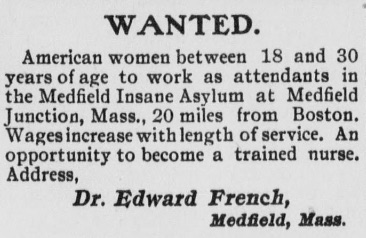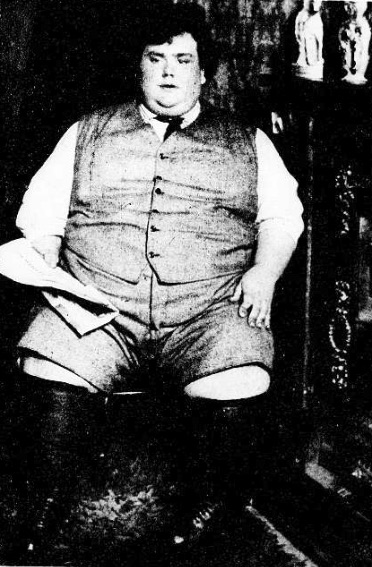
The Medfield Insane Asylum, in Medfield, Massachusetts, was established in 1892 and in only a few years, stories about the asylum began to circulate among the population and in newspapers across the country. In 1914, the asylum was renamed the Medfield State Hospital, but that certainly did not change the reputation of the hospital.
1. Blatant Racial Discrimination
Miss Jane R. Bosfield was a certified stenographer with an excellent reference from the clerk of the juvenile court. When she applied to work as a stenographer at Medfield Insane Asylum, she was, of course, called to the position. However, when Miss Bosfield arrived at the asylum, Dr. French was extremely displeased and told Miss Bosfield that he wished to have the services of a white stenographer and not a woman of color.
Miss Bosfield persevered and stayed to work as a stenographer at the asylum. During that time, she was forced to take her meals and live in a room that was a half mile away from the asylum. Later she was sent to room in the chapel which was near the morgue. She was also instructed to take her meals there, as well.
By this time, Miss Bosfield had had enough of the nonsense and attempted to eat her meals in the asylum’s dining room with her co-workers. Each time she entered the dining room to take her meal she was immediately sent out until finally Dr. French fired her for insubordination.
In 1916, Miss Bosfield took her case against the asylum all the way to the Supreme Court where it was dismissed because “Dr. French had acted within his rights” to assign eating areas to the employees of the asylum. Dr. French claimed he was not discriminating against her due to the color of her skin. He simply wanted her to take her meals separate from her white co-workers.[1]

2. Patient Beaten to Death
Apparently 1916 was not a good year for Dr. Edward French because he saw himself in court again that year. This time it was for the death of a patient.
Three of the asylum’s attendants were on trial for manslaughter: Thomas McGrath, Frank Hale, and Wesley R. Lenton.
On September 26, 1916, Camillo Strazzullo, a patient at the asylum, died. On examination, a medical examiner discovered that the patient had been brutally beaten. He had internal injuries, 12 of his ribs had been fractured, and there were injuries to his skull.
Three attendants were arrested for the brutal murder, but during the trial, Dr. French, the asylum’s superintendent, took the stand and claimed that the patient had attacked one of the attendants and that the other two attendants had rushed to his aid.
“There was a struggle with the patient, Dr. French testified, and the men said they had difficulty in subduing him, although they denied that they had used violence.”
Attendant Lenton (sometimes printed as Linton) was found guilty of manslaughter and was sentenced to three years imprisonment. The other two attendants were merely dismissed from their jobs. [2]

3. Crushed Her Skull
Not only were there cases of attendants harming inmates at the asylum, but there were plenty of reports of violence among inmates. For example, in 1902 it was reported that Sarah McCormick, age 30, was murdered by another inmate.
According to the report, Sarah was strapped to her bed while another inmate was cleaning the floor:
“With the heavy iron polisher she used at her work, she attacked her helpless victim, crushing the right side of her skull by a terrible blow.” [3]

4. Patient Boiled Alive
On November 30, 1897, a 42-year-old patient, William W. Spearing was placed in a bathtub. The attendant turned on the hot water and neglected to turn on the cold water. The attendant stepped away and when he returned, the patient was sitting in scalding hot water.
The patient was removed from the water, but it was too late. He died a painful death.
In the words of Dr. French,
“It was one of those accidents that are liable to occur at any time. I discharged the attendant as soon as he told his story. The attendants have their rules to go by in the matter of giving baths and these certainly were violated.”
As to why the patient did not react to the super hot water, Dr. French said that the patient had not feeling in the skin and did not feel the initial pain of the hot water. [4]
5. Escaped to Her Death
Patients escaped from the asylum, just like they sometimes do in today’s institutes. While most escapees are caught, one woman was not that fortunate.
In 1896, Mary E. Fitzgibbons escaped from the Medfield Insane Asylum in the middle of winter. In early spring, her body was found half buried in snow at the Castle Hill Golf Links. [5]

6. Mysterious Postcards
It was reported in 1922 that for the previous 30 years, the Boston police department received a postcard on the first of every month. The postcard was postmarked “Medfield” and the only word written in the message section was “Medfield.”
The police could not figure out why someone was sending them postcards and checked to see if it was a crazy patient in the Medfield asylum. A quick investigation told them that the postcards were not coming from inside the asylum.
In July of 1922, something changed about the postcards. Instead of being sent from Medfield, the cards were being mailed from Green Harbor, but they still only had one word written on them: “Medfield.” [6]

